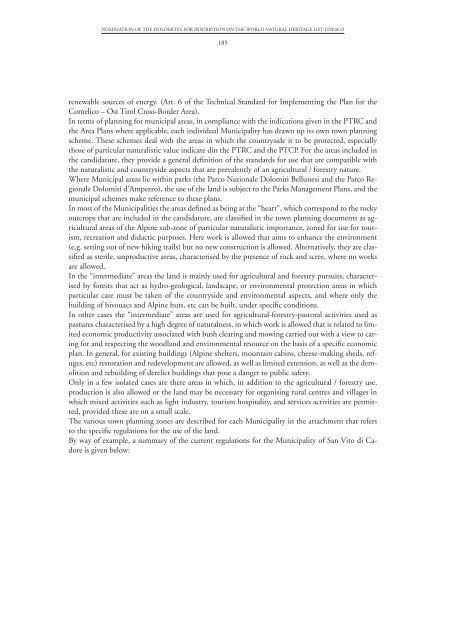DOLOMITES - Annexes 2-8 - Provincia di Udine
DOLOMITES - Annexes 2-8 - Provincia di Udine
DOLOMITES - Annexes 2-8 - Provincia di Udine
Create successful ePaper yourself
Turn your PDF publications into a flip-book with our unique Google optimized e-Paper software.
NOMINATION OF THE <strong>DOLOMITES</strong> FOR INSCRIPTION ON THE WORLD NATURAL HERITAGE LIST UNESCO<br />
185<br />
renewable sources of energy. (Art. 6 of the Technical Standard for Implementing the Plan for the<br />
Comelico – Ost Tirol Cross-Border Area).<br />
In terms of planning for municipal areas, in compliance with the in<strong>di</strong>cations given in the PTRC and<br />
the Area Plans where applicable, each in<strong>di</strong>vidual Municipality has drawn up its own town planning<br />
scheme. These schemes deal with the areas in which the countryside it to be protected, especially<br />
those of particular naturalistic value in<strong>di</strong>cate <strong>di</strong>n the PTRC and the PTCP. For the areas included in<br />
the can<strong>di</strong>dature, they provide a general definition of the standards for use that are compatible with<br />
the naturalistic and countryside aspects that are prevalently of an agricultural / forestry nature.<br />
Where Municipal areas lie within parks (the Parco Nazionale Dolomiti Bellunesi and the Parco Regionale<br />
Dolomiti d’Ampezzo), the use of the land is subject to the Parks Management Plans, and the<br />
municipal schemes make reference to these plans.<br />
In most of the Municipalities the areas defined as being at the “heart”, which correspond to the rocky<br />
outcrops that are included in the can<strong>di</strong>dature, are classified in the town planning documents as agricultural<br />
areas of the Alpine sub-zone of particular naturalistic importance, zoned for use for tourism,<br />
recreation and <strong>di</strong>dactic purposes. Here work is allowed that aims to enhance the environment<br />
(e.g. setting out of new hiking trails) but no new construction is allowed. Alternatively, they are classified<br />
as sterile, unproductive areas, characterised by the presence of rock and scree, where no works<br />
are allowed.<br />
In the “interme<strong>di</strong>ate” areas the land is mainly used for agricultural and forestry pursuits, characterised<br />
by forests that act as hydro-geological, landscape, or environmental protection areas in which<br />
particular care must be taken of the countryside and environmental aspects, and where only the<br />
buil<strong>di</strong>ng of bivouacs and Alpine huts, etc can be built, under specific con<strong>di</strong>tions.<br />
In other cases the “interme<strong>di</strong>ate” areas are used for agricultural-forestry-pastoral activities used as<br />
pastures characterised by a high degree of naturalness, in which work is allowed that is related to limited<br />
economic productivity associated with bush clearing and mowing carried out with a view to caring<br />
for and respecting the woodland and environmental resource on the basis of a specific economic<br />
plan. In general, for existing buil<strong>di</strong>ngs (Alpine shelters, mountain cabins, cheese-making sheds, refuges,<br />
etc) restoration and redevelopment are allowed, as well as limited extension, as well as the demolition<br />
and rebuil<strong>di</strong>ng of derelict buil<strong>di</strong>ngs that pose a danger to public safety.<br />
Only in a few isolated cases are there areas in which, in ad<strong>di</strong>tion to the agricultural / forestry use,<br />
production is also allowed or the land may be necessary for organising rural centres and villages in<br />
which mixed activities such as light industry, tourism hospitality, and services activities are permitted,<br />
provided these are on a small scale.<br />
The various town planning zones are described for each Municipality in the attachment that refers<br />
to the specific regulations for the use of the land.<br />
By way of example, a summary of the current regulations for the Municipality of San Vito <strong>di</strong> Cadore<br />
is given below:

















